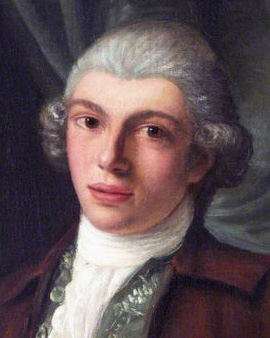


Not too much is known about the youth of Thomas Luny. They only know his year of birth and know that he is from Cornwall, possibly from the parish of St Ewe. In any case, the sea was very close where he grew up. So it can be explained that from childhood on he was fascinated by the wet element and seascapes. Already at the age of 11, little Luny came to London to be apprenticed to the painter Francis Holman, who came from a family of shipowners and whose paintings were almost exclusively concerned with the sea and the coasts. It was from this first teacher, with whom he stayed for 10 years, that Luny's lifelong enthusiasm for seascapes most probably originated. At the age of 18 he exhibited his first painting at the Society of Artists London. It was entitled "A Distant View of Madeira Island and Porto Santo". It is very unlikely that he ever saw Madeira with his own eyes. Rather, he was inspired by an engraving. This is how he later created a painting of a battle on the Nile and the bombing of Algiers. In both places, he was probably not personal. However, during his time with Holman, he once travelled through France.
After leaving the studio of his teacher and mentor in 1870, Thomas Luny moved to London's Leadenhall Street. Here he met a Mr Merle. He was a shrewd trader and a kind of artist's agent. The painter owed him a very successful marketing of his paintings for 20 years. During this time, he also exhibited many of his works at the Royal Academy. The residence Leadenhall Street proved to be another advantage. The British East India Company also had its headquarters in the house and their officers liked to buy his paintings and had themselves and their families portrayed by him. They even took him on their ships a few times, so he came to Gibraltar and Naples once.
At the age of about 50 Thomas Luny moved from London to Teignmouth in Devon. At that time he was already suffering from health problems and had arthritis in both hands. Nevertheless, he continued to be very productive and painted until his death in 1837, his work comprises about 3,300 paintings.

Not too much is known about the youth of Thomas Luny. They only know his year of birth and know that he is from Cornwall, possibly from the parish of St Ewe. In any case, the sea was very close where he grew up. So it can be explained that from childhood on he was fascinated by the wet element and seascapes. Already at the age of 11, little Luny came to London to be apprenticed to the painter Francis Holman, who came from a family of shipowners and whose paintings were almost exclusively concerned with the sea and the coasts. It was from this first teacher, with whom he stayed for 10 years, that Luny's lifelong enthusiasm for seascapes most probably originated. At the age of 18 he exhibited his first painting at the Society of Artists London. It was entitled "A Distant View of Madeira Island and Porto Santo". It is very unlikely that he ever saw Madeira with his own eyes. Rather, he was inspired by an engraving. This is how he later created a painting of a battle on the Nile and the bombing of Algiers. In both places, he was probably not personal. However, during his time with Holman, he once travelled through France.
After leaving the studio of his teacher and mentor in 1870, Thomas Luny moved to London's Leadenhall Street. Here he met a Mr Merle. He was a shrewd trader and a kind of artist's agent. The painter owed him a very successful marketing of his paintings for 20 years. During this time, he also exhibited many of his works at the Royal Academy. The residence Leadenhall Street proved to be another advantage. The British East India Company also had its headquarters in the house and their officers liked to buy his paintings and had themselves and their families portrayed by him. They even took him on their ships a few times, so he came to Gibraltar and Naples once.
At the age of about 50 Thomas Luny moved from London to Teignmouth in Devon. At that time he was already suffering from health problems and had arthritis in both hands. Nevertheless, he continued to be very productive and painted until his death in 1837, his work comprises about 3,300 paintings.
Page 1 / 1






